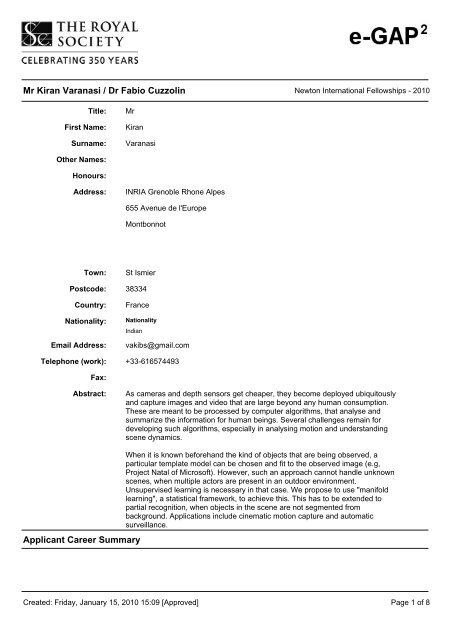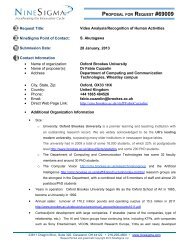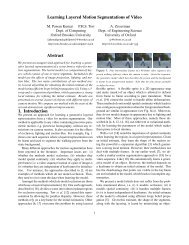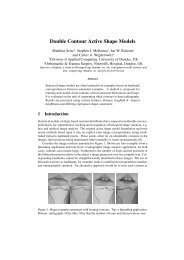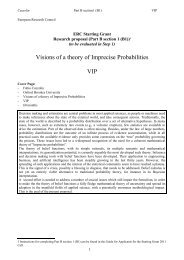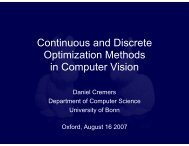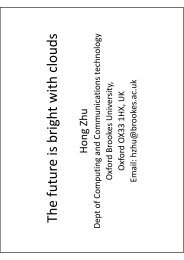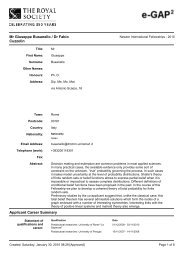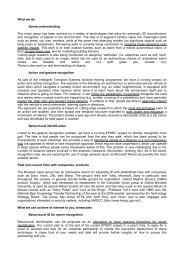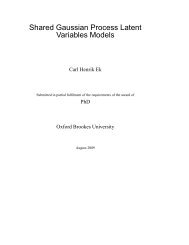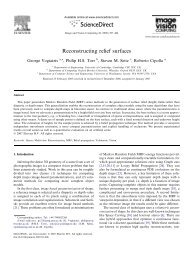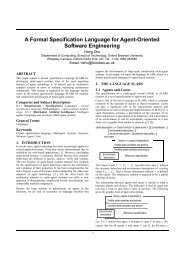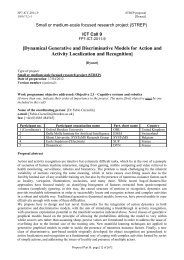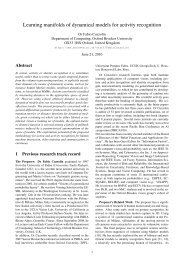Mr Kiran Varanasi / Dr Fabio Cuzzolin Applicant Career Summary
Mr Kiran Varanasi / Dr Fabio Cuzzolin Applicant Career Summary
Mr Kiran Varanasi / Dr Fabio Cuzzolin Applicant Career Summary
Create successful ePaper yourself
Turn your PDF publications into a flip-book with our unique Google optimized e-Paper software.
<strong>Mr</strong> <strong>Kiran</strong> <strong>Varanasi</strong> / <strong>Dr</strong> <strong>Fabio</strong> <strong>Cuzzolin</strong><br />
Title:<br />
First Name:<br />
Surname:<br />
Other Names:<br />
Honours:<br />
Address:<br />
Town:<br />
Postcode:<br />
Country:<br />
Nationality:<br />
Email Address:<br />
Telephone (work):<br />
Fax:<br />
Abstract:<br />
<strong>Mr</strong><br />
<strong>Kiran</strong><br />
<strong>Varanasi</strong><br />
655 Avenue de l'Europe<br />
Montbonnot<br />
St Ismier<br />
38334<br />
France<br />
Nationality<br />
Indian<br />
<strong>Applicant</strong> <strong>Career</strong> <strong>Summary</strong><br />
INRIA Grenoble Rhone Alpes<br />
vakibs@gmail.com<br />
+33-616574493<br />
Created: Friday, January 15, 2010 15:09 [Approved]<br />
Newton International Fellowships - 2010<br />
As cameras and depth sensors get cheaper, they become deployed ubiquitously<br />
and capture images and video that are large beyond any human consumption.<br />
These are meant to be processed by computer algorithms, that analyse and<br />
summarize the information for human beings. Several challenges remain for<br />
developing such algorithms, especially in analysing motion and understanding<br />
scene dynamics.<br />
When it is known beforehand the kind of objects that are being observed, a<br />
particular template model can be chosen and fit to the observed image (e.g,<br />
Project Natal of Microsoft). However, such an approach cannot handle unknown<br />
scenes, when multiple actors are present in an outdoor environment.<br />
Unsupervised learning is necessary in that case. We propose to use "manifold<br />
learning", a statistical framework, to achieve this. This has to be extended to<br />
partial recognition, when objects in the scene are not segmented from<br />
background. Applications include cinematic motion capture and automatic<br />
surveillance.<br />
Page 1 of 8
<strong>Mr</strong> <strong>Kiran</strong> <strong>Varanasi</strong> / <strong>Dr</strong> <strong>Fabio</strong> <strong>Cuzzolin</strong> Newton International Fellowships - 2010<br />
Statement of<br />
qualifications and<br />
career:<br />
Field of Specialisation:<br />
Publications:<br />
Subject:<br />
Present Research:<br />
Present Position:<br />
Present Employer:<br />
Research Assistant, Center for Visual Information<br />
Technology, IIIT Hyderabad, India<br />
Principal Mentor (Instructor for computer graphics<br />
course), MSIT Program, India<br />
Research Associate, ISRI, Carnegie Mellon University,<br />
USA<br />
INRIA Grenoble Rhone Alpes<br />
Created: Friday, January 15, 2010 15:09 [Approved]<br />
Qualification Date<br />
Ph.D Fellow, INRIA Rhône Alpes, Grenoble, France 26/11/2006 - 25/05/2010<br />
01/04/2004 - 31/10/2006<br />
01/08/2004 - 31/03/2005<br />
01/06/2003 - 31/12/2003<br />
Computer Vision, Spatio-temporal modeling of dynamic scenes, 3D features for<br />
matching and recognition, Tracking from images<br />
"Temporal surface tracking via mesh evolution"<br />
<strong>Kiran</strong> <strong>Varanasi</strong>, Andrei Zaharescu, Edmond Boyer, Radu Horaud<br />
European Conference on Computer Vision (ECCV), Marseille, October 2008<br />
(Oral Presentation : 5% acceptance rate)<br />
"Surface feature detection and description with application to mesh matching"<br />
Andrei Zaharescu, Edmond Boyer, <strong>Kiran</strong> <strong>Varanasi</strong>, Radu Horaud<br />
International Conference on Computer Vision and Pattern Recognition (CVPR),<br />
Miami, June 2009<br />
"A document space model for automated text classification based on frequency<br />
distribution across categories"<br />
<strong>Kiran</strong> <strong>Varanasi</strong>, Chaitanya Kamisetty, Sushma Bendre, Rajeev Sangal, Akshar<br />
Bharati<br />
International Conference on Natural Language Processing (ICON), Mumbai,<br />
December 2002<br />
NIF Group 05: Information communication technology (ICT) / Computer Vision -<br />
ICT<br />
Through synchronized cameras in an indoor setting, a multi-view video is captured<br />
of different actors performing diverse tasks and interacting with each other. 3D<br />
mesh-models of the scene are built independently, by extracting silhouettes at<br />
each frame. These meshes are not topologically or geometrically coherent, due to<br />
artefacts in silhouette extractions and by occlusions. I have worked on obtaining a<br />
coherent spatio-temporal model of the observed scene, which connects these<br />
meshes.<br />
I worked on dense 3D motion estimation, which is a particularly hard problem<br />
when no assumptions can be made of the scene, as that it has a single topology<br />
over time. I demonstrated results on complex sequences, e.g, a dancer wearing a<br />
loose fitting robe with a feather boa belt, a juggler juggling with clubs, two children<br />
playing ball with each other etc. No additional information was input, apart from<br />
that captured by the cameras. I achieved this through a mesh evolution framework<br />
which accounts for topological changes.<br />
Later, I worked on computing 3D features directly on meshes, which can be used<br />
for initializing global motion estimation.<br />
Finally, I worked on a temporally coherent segmentation scheme to automatically<br />
extract body-parts that move rigidly over time. I demonstrated results on similar<br />
complex sequences involving multiple actors and background clutter (recent work<br />
submitted for publication).<br />
Thus, spatio-temporal modelling of arbitrary scenes is achieved at various scales.<br />
Doctoral Student<br />
Page 2 of 8
<strong>Mr</strong> <strong>Kiran</strong> <strong>Varanasi</strong> / <strong>Dr</strong> <strong>Fabio</strong> <strong>Cuzzolin</strong> Newton International Fellowships - 2010<br />
Present Department:<br />
Present Position Start<br />
Date:<br />
Present Position End<br />
Date:<br />
PhD Awarded Date:<br />
PhD Institution:<br />
PhD Country:<br />
Previous Support<br />
Description:<br />
Where did you hear of<br />
this scheme?:<br />
26/11/2006<br />
25/05/2010<br />
Co-<strong>Applicant</strong> <strong>Career</strong> <strong>Summary</strong><br />
Created: Friday, January 15, 2010 15:09 [Approved]<br />
Perception Group (Computer Science Department)<br />
30/06/2010<br />
INRIA Grenoble Rhône Alpes and Laboratoire Jean Kuntzmann, Université<br />
Grenoble<br />
France<br />
Employed by INRIA Grenoble. Supported by the INTERACT project of<br />
PERCEPTION group (European Grant)<br />
Other<br />
Co-<strong>Applicant</strong> Personal Details<br />
Title:<br />
First Name:<br />
Surname:<br />
Other Names:<br />
Honours:<br />
Address Line 1:<br />
Address Line 2:<br />
Address Line 3:<br />
Address Line 4:<br />
Address Line 5:<br />
Town:<br />
Postcode:<br />
Country:<br />
Nationality:<br />
Email Address:<br />
Telephone (work):<br />
Fax:<br />
<strong>Dr</strong><br />
<strong>Fabio</strong><br />
<strong>Cuzzolin</strong><br />
Ph.D.<br />
Department of Computing<br />
Oxford Brookes University<br />
Wheatley campus<br />
Wheatley<br />
OX33 1HX<br />
United Kingdom<br />
Nationality<br />
Italian<br />
fabio.cuzzolin@brookes.ac.uk<br />
01865 484526<br />
01865 484545<br />
Page 3 of 8
<strong>Mr</strong> <strong>Kiran</strong> <strong>Varanasi</strong> / <strong>Dr</strong> <strong>Fabio</strong> <strong>Cuzzolin</strong> Newton International Fellowships - 2010<br />
Statement of<br />
qualifications and<br />
career:<br />
Field of Specialisation:<br />
Publications:<br />
Subject:<br />
Present Research:<br />
Present Position:<br />
Present Employer:<br />
Present Department:<br />
Marie Curie Fellow, INRIA Rhone-Alpes, Grenoble,<br />
France<br />
Post-doctoral researcher, University of California at<br />
Los Angeles<br />
Fixed-term assistant professor, Politecnico di Milano,<br />
Italy<br />
Lecturer - Early <strong>Career</strong> Fellow<br />
Oxford Brookes University<br />
Department of Computing<br />
Created: Friday, January 15, 2010 15:09 [Approved]<br />
Qualification Date<br />
Lecturer, Oxford Brookes University 01/09/2008 - to date<br />
04/09/2006 - 03/09/2008<br />
01/10/2004-09/04/2006<br />
01/01/2003-31/12/2004<br />
Post-doctoral researcher, University of Padua, Italy 01/06/2001-31/05/2003<br />
<strong>Dr</strong> <strong>Cuzzolin</strong>’s research interests include machine and manifold learning, computer<br />
vision and human motion analysis, the theory of belief functions and imprecise<br />
probabilities.<br />
<strong>Fabio</strong> <strong>Cuzzolin</strong>, Multilinear modeling for robust identity recognition from gait, in<br />
“Behavioral Biometrics for Human Identification: Intelligent Applications", Liang<br />
Wang and Xin Geng (Eds.), IGI Publishing, 2009<br />
<strong>Fabio</strong> <strong>Cuzzolin</strong>, A geometric approach to the theory of evidence, IEEE<br />
Transactions on Systems, Man, and Cybernetics part C, 38(4), pages 522-534,<br />
July 2008<br />
<strong>Fabio</strong> <strong>Cuzzolin</strong>, Diana Mateus, David Knossow, Edmond Boyer, and Radu<br />
Horaud, Coherent Laplacian protrusion segmentation, Proceedings of CVPR'08,<br />
Anchorage, Alaska;<br />
Diana Mateus, Radu Horaud, David Knossow, <strong>Fabio</strong> <strong>Cuzzolin</strong>, and Edmond<br />
Boyer, Articulated Shape Matching Using Laplacian Eigenfunctions and<br />
Unsupervised Point Registration, Proceedings of CVPR'08, Anchorage, Alaska;<br />
<strong>Fabio</strong> <strong>Cuzzolin</strong>, Using Bilinear Models for View-invariant Action and Identity<br />
Recognition, Proceedings of<br />
CVPR'06, pp. 1701-1708, New York, June 18-22 2006<br />
NIF Group 05: Information communication technology (ICT) / Computer Vision -<br />
ICT<br />
<strong>Dr</strong> <strong>Cuzzolin</strong>’s research interests include machine learning, computer vision and<br />
imprecise probabilities.<br />
He is first or single author of some 50 publications (including 9 journals + 6 under<br />
review), some of which received awards. He collaborates with several journals in<br />
both computer vision and probabilities, and served in the program committee of<br />
some 15 international conferences.<br />
<strong>Dr</strong> <strong>Cuzzolin</strong> is a prominent expert in the field of random sets. He formulated a<br />
geometric approach to uncertainty in which probabilities, possibilities and belief<br />
functions can all be represented as points of a Cartesian space and there<br />
analyzed. He studied how to approximate random sets with probabilities, and<br />
proposed novel formulations of the theory of belief functions.<br />
Within computer vision, his work focused on human motion analysis and action<br />
recognition. He proposed the use of multilinear models for identity recognition<br />
from gait, and explored spectral motion capture techniques for unsupervised 3D<br />
segmentation and matching.<br />
<strong>Dr</strong> <strong>Cuzzolin</strong> is finalizing collaborations with IDSIA, Switzerland for a STREP on<br />
imprecise Markov chains for gesture recognition, and with INRIA, Pompeu Fabra<br />
and Technion on a Future and Emerging Technology (FET) EU proposal on large<br />
scale manifold learning. He is discussing a collaborative project on uncertainty<br />
theory at UK level with U. Bristol and Durham’s Dept of Statistics. He is also<br />
exploring the opportunity of a European Network of Excellence in the same fiel<br />
Page 4 of 8
<strong>Mr</strong> <strong>Kiran</strong> <strong>Varanasi</strong> / <strong>Dr</strong> <strong>Fabio</strong> <strong>Cuzzolin</strong> Newton International Fellowships - 2010<br />
Present Position Start<br />
Date:<br />
Present Position End<br />
Date:<br />
PhD Awarded Date:<br />
Proposal<br />
Current Funding<br />
Description:<br />
Previous Support<br />
Description:<br />
Subject:<br />
Project Title:<br />
Start Date:<br />
End Date:<br />
Research proposal:<br />
01/09/2008<br />
31/08/2013<br />
19/02/2001<br />
Created: Friday, January 15, 2010 15:09 [Approved]<br />
<strong>Dr</strong> <strong>Cuzzolin</strong> is currently applying for his EPSRC First Grant, he is finalizing a FET<br />
(Future Emerging Technology) EU FP7 project with as partners INRIA Rhone-<br />
Alpes, U. Pompeu Fabra (Barcelona), and Technion (Haifa). He is also preparing<br />
a Leverhulme research proposal, and will submit a European Research Council<br />
Starting Grant before October 2010. No funding though is currently available.<br />
<strong>Dr</strong> <strong>Cuzzolin</strong> has received Oxford Brookes' central university funding in 2008<br />
(some 3600 pounds overall).<br />
NIF Group 05: Information communication technology (ICT) / Computer Vision -<br />
ICT<br />
Manifold learning for motion analysis and recognition<br />
01/01/2011<br />
31/12/2012<br />
In the course of this project, we will explore the problem of recognizing objects<br />
and their motion in an unknown environment filled with background clutter. One<br />
good example is the recognition of human activities in an outdoor environment,<br />
from a single image or from a set of images, obtained from cameras or depth<br />
sensors. In this case, we aim to recognize the human beings in the scene, their<br />
body postures and their motion over time. Our problem is made complex by the<br />
facts that the people need not be visible entirely to the camera, that they might<br />
wear loose clothes which cause further occlusions, and that they might interact<br />
with each other using various unknown objects.<br />
In contrast, if it is known that a person faces straight to the sensor, or at least, that<br />
he/she is visible entirely to the sensor's field of view, a known articulated model of<br />
human beings can be fit to the observed image and the pose of the body be<br />
computed. Certain commercial applications are in the course of development (e.g,<br />
Project Natal of Microsoft corporation) which use cameras and depth sensors in<br />
this way, to compute body poses and provide novel modes of interaction for users<br />
to play computer games. The variations in human body shapes and their poses<br />
are learnt into a statistical model, using a vast database of actors captured in a<br />
pre-defined set of poses. Apart from commercial ventures, there have also been<br />
various research publications that studied this problem in the recent past. Diverse<br />
solutions have been proposed to define and represent such statistical model, and<br />
to compute the closest fit for an observation.<br />
One such solution was proposed by <strong>Dr</strong>. <strong>Cuzzolin</strong> et al, through manifold learning.<br />
The observation is transformed into a new space using adaptive spectral<br />
embeddings that are isometrically invariant (i.e, that are invariant to articulated<br />
motions). Articulated motion can be estimated as a simple global rotation in this<br />
embedding space. The power of this solution is its generality, as it can be used for<br />
motion estimation of an unknown object, not necessarily a human being.<br />
However, its weakness is that the object needs to be segmented properly from the<br />
background, which is difficult to achieve in a natural setting, or when multiple<br />
actors are present.<br />
Page 5 of 8
<strong>Mr</strong> <strong>Kiran</strong> <strong>Varanasi</strong> / <strong>Dr</strong> <strong>Fabio</strong> <strong>Cuzzolin</strong> Newton International Fellowships - 2010<br />
Created: Friday, January 15, 2010 15:09 [Approved]<br />
During my Ph.D, I have worked on the problem of motion estimation without<br />
segmenting an object from background clutter. I demonstrated results on scenes<br />
involving multiple actors interacting with each other. To achieve this, I used a<br />
mesh evolution framework that handles topological changes. I proposed methods<br />
for computing local 3D features on objects, and algorithms for matching shapes<br />
that rely on such local features. Such methods can handle partial shape matching,<br />
and work even when the object is not entirely visible to the sensor.<br />
In the current project, we aim at combining the strengths of the two approaches<br />
developed by applicant and co-applicant and fit them into a statistical learning<br />
framework. The first challenge that we face is the huge dimensionality of the input<br />
data. Even though adaptive spectral embeddings translate this input into a new<br />
space of much lower dimensionality, they have to be first learnt by training. When<br />
the dimensionality of the input data is prohibitively large (as is in our case), the<br />
learning takes too much time and needs too much memory space. We would like<br />
to attack this problem by using the idea of "compressed sensing" that has recently<br />
become popular in the signal processing community. We shall code the input data<br />
using random projections that are linear, sparsity oriented and metric-preserving.<br />
This vastly reduces the dimensionality of the feature space and makes adaptive<br />
embeddings tractable.<br />
Adaptive spectral embeddings can handle global matching, but not partial<br />
matching. Our second challenge is to fit these embeddings into a partial matching<br />
framework. Similar to my Ph.D work, we would like to derive feature descriptors<br />
on these embeddings that are local in scope, and which can be used for matching<br />
shapes amidst background clutter. Ideally, we should be able to learn body-parts<br />
of the shapes, with their distinctive shape signatures.<br />
The third and final challenge that we will have to address is that of unsupervised<br />
learning over a large database of example shapes and poses. This learning will<br />
further improve the descriptiveness of our features. For example, statistical<br />
learning can restrict the lower arm of a human body to have a joint angle not more<br />
than 180 degrees with the upper arm. We seek to learn the shape and motion<br />
statistics of arbitrary shapes, not just human beings. For example, we can learn<br />
the statistics of men riding bicycles, or of children playing with their pets.<br />
The potential applications of the proposed work are numerous. A straightforward<br />
application, for instance, is kinematic motion capture in outdoor environments,<br />
crucial in the entertainment industry, such as in film production and gaming. A<br />
second natural application is automatic visual surveillance, especially in crowded<br />
and cluttered scenes where the suspect is on the run. An additional example<br />
concerns the assistance of elderly people, through monitoring for signs of ageing<br />
and weakness in their limb movements. A fourth application could be in sports<br />
analysis, where the movements of a sports-person are analysed for their<br />
correctness. Due to the general-purpose nature of our approach, it shall be able<br />
for deployment amidst multiple people performing diverse tasks, and in outdoor<br />
environments. This opens doors for several new applications, to a degree that is<br />
not possible with today's technology.<br />
Apart from practical applications, there shall also be theoretical breakthroughs that<br />
would be of interest, for various other fields that fit in the broad scope of pervasive<br />
computing. Bringing together the two fields of manifold learning and compressed<br />
sensing fits the broader research goal of <strong>Dr</strong>. <strong>Cuzzolin</strong>, as outlined by his<br />
collaboration with other European centers of research. The task of analysing<br />
motion (and human activities in particular) fits well with the long-term goals of the<br />
Vision Group of Oxford Brookes University, which has produced several worldclass<br />
publications in this field. I would like to benefit from the strong collaborations<br />
that tie the group in Oxford Brookes to other centres of excellence in the world,<br />
particularly to the Visual Geometry group in the University of Oxford and to the<br />
Page 6 of 8
<strong>Mr</strong> <strong>Kiran</strong> <strong>Varanasi</strong> / <strong>Dr</strong> <strong>Fabio</strong> <strong>Cuzzolin</strong> Newton International Fellowships - 2010<br />
Accompanying<br />
dependants:<br />
Previous contact:<br />
Potential applications:<br />
Comply with Policy on<br />
use of Animals:<br />
Proficient in reading,<br />
writing & speaking<br />
English:<br />
Benefits to<br />
individuals/institutions<br />
:<br />
Benefits to UK:<br />
none<br />
Not applicable<br />
Created: Friday, January 15, 2010 15:09 [Approved]<br />
Perception Group at INRIA Grenoble (where I am pursuing my Ph.D at the<br />
moment). The scope for collaboration is much higher at the later stages of the<br />
project, when we devise applications in motion capture, or in visual surveillance.<br />
Here, it is noteworthy to mention the highly successful industrial partnerships of<br />
the Vision group in Oxford Brookes. For example, the collaboration with the<br />
motion capture company Vicon has won the prestigious knowledge transfer<br />
partnership (KTP) in 2009.<br />
I have known <strong>Dr</strong>. <strong>Fabio</strong> <strong>Cuzzolin</strong> at INRIA Grenoble in France for 2 years, where<br />
we have participated together in seminars and lab-meetings. At INRIA, <strong>Dr</strong>.<br />
<strong>Cuzzolin</strong> and I have worked on similar problems (in 3D motion estimation), but<br />
from different perspectives. It provided us the opportunity to critique each other's<br />
ideas, and also to identify the individual strengths of our approaches. I wish to<br />
capitalize on that exchange, and collaborate more rigorously with <strong>Dr</strong>. <strong>Cuzzolin</strong>.<br />
Excellent reading, writing and spoken English capabilities. Received all<br />
professional education in English for the last 10 years. TOEFL 287/300<br />
Images and videos from visual sensors provide a wealth of information, potentially<br />
allowing more natural forms of interaction between humans and machines. This<br />
data, however, is bulky and expensive to store or transmit: its efficient but faithful<br />
representation could allow applications currently forbidden because of the scale of<br />
the data involved. Streamlining such interactions through cutting-edge large scale<br />
manifold learning will have enormous impact on productivity and as a<br />
consequence on economic growth. People will enjoy the effect of distributed<br />
computing on their lives, in the form of automated assistance to the elderly, or<br />
new home entertainment products not linked to inconvenient motion estimation<br />
devices. Companies active in entertainment, surveillance, and biometrics are all<br />
poised to receive clear benefits from such developments. Individuals' health will<br />
also benefit from advanced techniques of diagnosis based on semi-automatic<br />
recognition of diseases from 3D medical data.<br />
Clear benefits to the UK in terms of public security will come from the impact of<br />
the project on areas such as automatic surveillance. Biometrics such as face or<br />
iris recognition suffer from major limitations: they cannot be used at a distance,<br />
and require user cooperation, making them not practical in real-world scenarios.<br />
Methods based on gait analysis can be built on top of the proposed algorithm to<br />
design semi-automatic alert system with the potential of significantly improve the<br />
country's level of security.<br />
Besides, the scope of the techniques developed within the project is not limited to<br />
motion analysis or medical imaging. For instance, support to decision making and<br />
customization in business is another important area in which intelligent<br />
management of large amounts of data can have an impact. Using real time<br />
detailed data, products can be customized for individual clients, allowing<br />
companies to offer tailored services and boosting UK competitiveness.<br />
Page 7 of 8
<strong>Mr</strong> <strong>Kiran</strong> <strong>Varanasi</strong> / <strong>Dr</strong> <strong>Fabio</strong> <strong>Cuzzolin</strong> Newton International Fellowships - 2010<br />
Benefits to Overseas<br />
Country:<br />
Multidisciplinary<br />
Proposal:<br />
Financial Details<br />
Financial Details:<br />
Start Date:<br />
Duration (Years):<br />
Justification:<br />
Created: Friday, January 15, 2010 15:09 [Approved]<br />
The community’s awareness of the need for new, radical ways of learning from<br />
and making decisions based large scale data is arising. The Lisbon Strategy for<br />
growth and jobs explicitly mentions the need for Europe, and France in particular,<br />
to keep open to the most recent developments in ICT research. Failure to lead the<br />
mounting tide in large scale data management and learning, an issue at the root<br />
of most components of the connected society of the near future, would<br />
compromise the continent’s competitiveness and put serious obstacles before the<br />
realization of such scenarios.<br />
The potential of non-traditional manifold learning techniques in allowing efficient<br />
communication between different agents/sensors is apparent, making scenarios in<br />
which self-organizing systems (such as, for instance, self-organizing traffic lights)<br />
will adapt autonomously to changing requirements, reducing the need for human<br />
intervention or even centrally directed autonomous planning, realistic.<br />
Year Payment type Justification Amount Requested<br />
Year 1 Travel International 2,000.00<br />
Year 1 Other 0.00<br />
Year 1 Subsistence 24,000.00<br />
Year 1 Research Costs 8,000.00<br />
Year 2 Travel International 0.00<br />
Year 2 Other 0.00<br />
Year 2 Subsistence 24,000.00<br />
Year 2 Research Costs 8,000.00<br />
Total 66,000.00<br />
01/01/2011<br />
2<br />
£4000 per year for major international conferences (2 sums per year of £2000)<br />
£2000 per year for visits/seminars/collaborations travels in UK/Europe<br />
£2000 per year for equipment (eg cameras etc)<br />
Page 8 of 8


